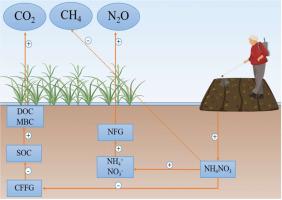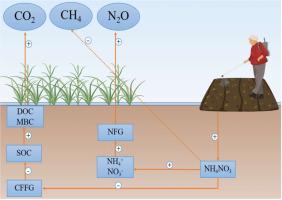Microbes drive more carbon dioxide and nitrous oxide emissions from wetland under long-term nitrogen enrichment
IF 12.4
1区 环境科学与生态学
Q1 ENGINEERING, ENVIRONMENTAL
引用次数: 0
Abstract
Wetlands are frequently regarded as weak carbon dioxide (CO2) sinks, the largest natural sources of methane (CH4), and weak sources of nitrous oxide (N2O). Anthropogenic activities and climate change-induced nitrogen (N) enrichment may affect wetland carbon (C) and N cycling via soil microbes, consequently modifying the original greenhouse gas (GHG) emissions. However, the effects and mechanisms of the duration and rate of N inputs on wetland GHG emissions remain uncertain and controversial. Therefore, this study conducted an in situ field experiment to investigate the effects and driving mechanisms of long-term N enrichment on wetland GHG emissions throughout the 2023 growing season by using the static opaque chambers method. Soil microbial composition and function were also analyzed through metagenomic sequencing. The results showed that N enrichment significantly increased wetland CO2 emissions, which were associated with the abundance of microbial C-fixing functional genes and the soil C content. Although nitrogen enrichment tended to suppress CH4 emissions, the effect was not significant. High N enrichment created a powerful wetland N2O source driven by the abundance of microbial nitrification function genes and microbial species. Vegetation influenced wetland GHG emissions by altering soil carbon content. This study elucidates the response mechanism of wetland GHG emissions to long-term nitrogen enrichment, thereby furnishing a theoretical basis for wetland conservation and nitrogen management.


在长期富氮环境下,微生物驱动湿地排放更多的二氧化碳和氧化亚氮
湿地通常被认为是弱二氧化碳(CO2)汇,是甲烷(CH4)的最大天然来源,也是氧化亚氮(N2O)的弱来源。人类活动和气候变化诱导的氮(N)富集可能影响湿地碳(C)和氮通过土壤微生物的循环,从而改变原始温室气体(GHG)排放。然而,氮输入持续时间和速率对湿地温室气体排放的影响及其机制仍存在不确定性和争议。为此,本研究采用静态不透明室法,开展了2023年生长季长期N富集对湿地温室气体排放的影响及其驱动机制的原位田间试验。通过宏基因组测序分析土壤微生物组成和功能。结果表明,氮的富集显著增加了湿地的CO2排放量,这与微生物固碳功能基因的丰度和土壤碳含量有关。富氮虽然有抑制CH4排放的趋势,但效果不显著。在丰富的微生物硝化功能基因和微生物种类的驱动下,高N富集形成了强大的湿地N2O源。植被通过改变土壤碳含量影响湿地温室气体排放。本研究阐明了湿地温室气体排放对长期氮富集的响应机制,为湿地保护和氮管理提供理论依据。
本文章由计算机程序翻译,如有差异,请以英文原文为准。
求助全文
约1分钟内获得全文
求助全文
来源期刊

Water Research
环境科学-工程:环境
CiteScore
20.80
自引率
9.40%
发文量
1307
审稿时长
38 days
期刊介绍:
Water Research, along with its open access companion journal Water Research X, serves as a platform for publishing original research papers covering various aspects of the science and technology related to the anthropogenic water cycle, water quality, and its management worldwide. The audience targeted by the journal comprises biologists, chemical engineers, chemists, civil engineers, environmental engineers, limnologists, and microbiologists. The scope of the journal include:
•Treatment processes for water and wastewaters (municipal, agricultural, industrial, and on-site treatment), including resource recovery and residuals management;
•Urban hydrology including sewer systems, stormwater management, and green infrastructure;
•Drinking water treatment and distribution;
•Potable and non-potable water reuse;
•Sanitation, public health, and risk assessment;
•Anaerobic digestion, solid and hazardous waste management, including source characterization and the effects and control of leachates and gaseous emissions;
•Contaminants (chemical, microbial, anthropogenic particles such as nanoparticles or microplastics) and related water quality sensing, monitoring, fate, and assessment;
•Anthropogenic impacts on inland, tidal, coastal and urban waters, focusing on surface and ground waters, and point and non-point sources of pollution;
•Environmental restoration, linked to surface water, groundwater and groundwater remediation;
•Analysis of the interfaces between sediments and water, and between water and atmosphere, focusing specifically on anthropogenic impacts;
•Mathematical modelling, systems analysis, machine learning, and beneficial use of big data related to the anthropogenic water cycle;
•Socio-economic, policy, and regulations studies.
 求助内容:
求助内容: 应助结果提醒方式:
应助结果提醒方式:


